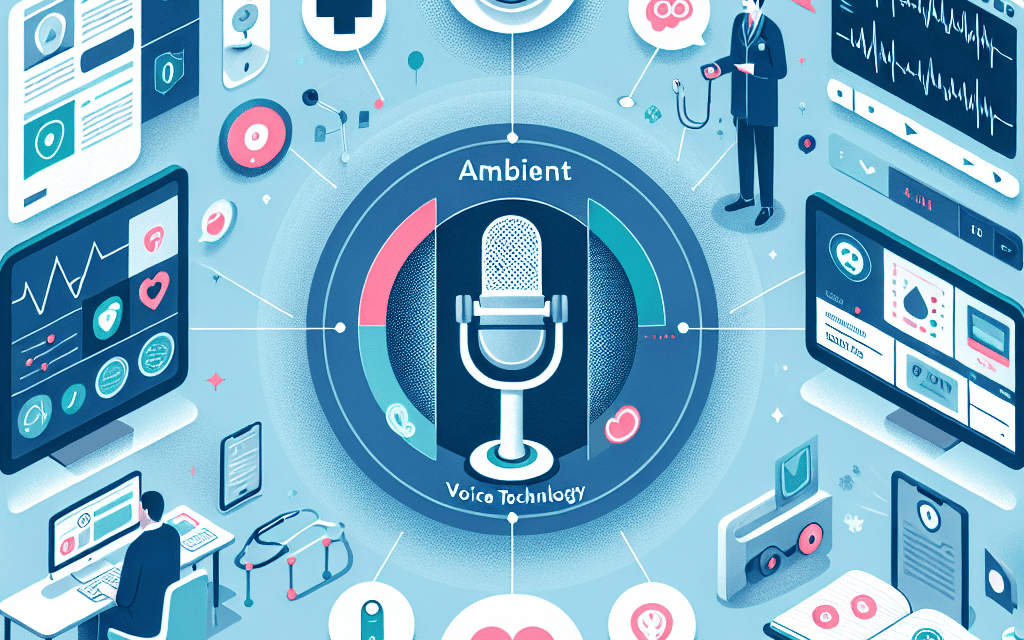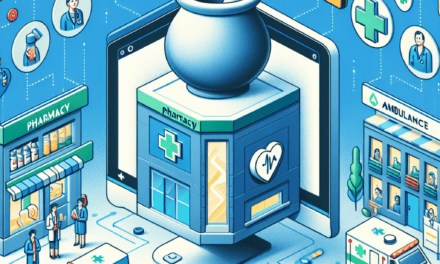Key Insights for Providers on Ambient Voice Technology and EHR Usability

In the rapidly evolving landscape of healthcare technology, ambient voice technology and electronic health record (EHR) usability have emerged as pivotal components in enhancing patient care and streamlining clinical workflows. As healthcare providers seek to optimize their operations and improve patient outcomes, understanding the integration and impact of these technologies is crucial. This article delves into the key insights for providers on ambient voice technology and EHR usability, offering a comprehensive exploration of their benefits, challenges, and future potential.
Understanding Ambient Voice Technology in Healthcare
Ambient voice technology refers to the use of voice-activated systems that operate in the background, allowing users to interact with technology through natural language. In healthcare, this technology is transforming the way providers interact with EHRs and other digital systems, offering a hands-free, intuitive interface that can significantly enhance clinical efficiency.
The Role of Ambient Voice Technology in Clinical Settings
Ambient voice technology is increasingly being integrated into clinical settings to facilitate seamless interactions between healthcare providers and digital systems. By enabling voice-activated commands, this technology allows clinicians to access patient records, input data, and retrieve information without the need for manual input, thereby reducing the cognitive load and minimizing disruptions during patient care.
For instance, a physician can use voice commands to update a patient’s medical history or order laboratory tests while maintaining eye contact with the patient, enhancing the overall patient experience. This hands-free interaction not only improves efficiency but also reduces the risk of errors associated with manual data entry.
Benefits of Ambient Voice Technology for Providers
The integration of ambient voice technology in healthcare settings offers numerous benefits for providers, including:
- Increased Efficiency: By streamlining data entry and retrieval processes, ambient voice technology allows providers to focus more on patient care rather than administrative tasks.
- Improved Accuracy: Voice recognition systems can reduce errors associated with manual data entry, ensuring that patient records are accurate and up-to-date.
- Enhanced Patient Engagement: Providers can maintain better eye contact and communication with patients, fostering a more personalized and empathetic care experience.
- Reduced Burnout: By alleviating the administrative burden, ambient voice technology can help reduce provider burnout, a significant issue in the healthcare industry.
Challenges in Implementing Ambient Voice Technology
Despite its potential benefits, the implementation of ambient voice technology in healthcare is not without challenges. Providers must navigate issues such as:
- Privacy and Security Concerns: Ensuring the confidentiality of patient information is paramount, and voice-activated systems must be designed to protect sensitive data.
- Integration with Existing Systems: Seamlessly integrating voice technology with existing EHR systems can be complex and may require significant investment in infrastructure and training.
- Accuracy and Reliability: Voice recognition systems must be highly accurate and reliable to be effective, necessitating ongoing updates and improvements.
Case Studies: Successful Implementation of Ambient Voice Technology
Several healthcare organizations have successfully implemented ambient voice technology, demonstrating its potential to transform clinical workflows. For example, a large hospital system in the United States integrated voice-activated systems into their EHR platform, resulting in a 30% reduction in time spent on documentation and a significant improvement in provider satisfaction.
Another case study from a primary care clinic showed that the use of ambient voice technology led to a 25% increase in patient interaction time, as providers were able to complete documentation tasks more efficiently.
The Future of Ambient Voice Technology in Healthcare
As ambient voice technology continues to evolve, its potential applications in healthcare are expanding. Future developments may include:
- Advanced Natural Language Processing: Enhancements in natural language processing could enable more complex interactions and improve the accuracy of voice recognition systems.
- Integration with AI and Machine Learning: Combining voice technology with AI and machine learning could enable predictive analytics and personalized care recommendations.
- Broader Adoption Across Specialties: As technology becomes more refined, its adoption is likely to expand beyond primary care to specialties such as surgery, radiology, and emergency medicine.
Enhancing EHR Usability for Healthcare Providers
Electronic health records (EHRs) are a cornerstone of modern healthcare, providing a digital platform for storing and managing patient information. However, the usability of EHR systems has been a longstanding challenge for providers, often contributing to inefficiencies and clinician burnout. Improving EHR usability is essential for optimizing clinical workflows and enhancing patient care.
The Importance of EHR Usability
EHR usability refers to the ease with which healthcare providers can interact with EHR systems to perform tasks efficiently and effectively. High usability is critical for ensuring that providers can access and input patient information quickly, reducing the time spent on administrative tasks and allowing for more focus on patient care.
Usability issues in EHR systems can lead to frustration, errors, and decreased productivity, ultimately impacting the quality of care provided to patients. Therefore, enhancing EHR usability is a priority for healthcare organizations seeking to improve clinical outcomes and provider satisfaction.
Key Factors Influencing EHR Usability
Several factors influence the usability of EHR systems, including:
- User Interface Design: A well-designed user interface is intuitive and easy to navigate, allowing providers to perform tasks efficiently without unnecessary complexity.
- System Performance: Fast and reliable system performance is essential for minimizing delays and ensuring that providers can access information when needed.
- Customization and Flexibility: EHR systems that offer customization options allow providers to tailor the interface to their specific needs and workflows.
- Interoperability: The ability to seamlessly exchange information with other systems and healthcare providers is crucial for comprehensive patient care.
Strategies for Improving EHR Usability
Healthcare organizations can implement several strategies to enhance EHR usability, including:
- User-Centered Design: Involving end-users in the design and development process ensures that the system meets their needs and preferences.
- Training and Support: Providing comprehensive training and ongoing support helps providers become proficient in using the EHR system and addresses any usability issues that arise.
- Regular Updates and Feedback: Continuously updating the system based on user feedback ensures that it remains relevant and effective in meeting clinical needs.
Case Studies: Successful EHR Usability Improvements
Several healthcare organizations have successfully improved EHR usability, resulting in enhanced clinical workflows and provider satisfaction. For example, a large healthcare system implemented a user-centered design approach to redesign their EHR interface, leading to a 40% reduction in documentation time and a significant increase in provider satisfaction.
Another case study from a community hospital demonstrated that providing targeted training and support for EHR users resulted in a 30% decrease in reported usability issues and improved overall system performance.
The Future of EHR Usability
As technology continues to advance, the future of EHR usability holds promise for further improvements. Potential developments include:
- Integration with Emerging Technologies: Incorporating technologies such as AI and machine learning could enhance decision support and streamline clinical workflows.
- Personalized User Experiences: Future EHR systems may offer more personalized user experiences, adapting to individual provider preferences and workflows.
- Greater Interoperability: Efforts to improve interoperability will enable more seamless information exchange across healthcare systems, enhancing care coordination.
The Intersection of Ambient Voice Technology and EHR Usability
The integration of ambient voice technology with EHR systems represents a significant opportunity to enhance usability and streamline clinical workflows. By combining the intuitive interface of voice technology with the comprehensive capabilities of EHRs, healthcare providers can achieve greater efficiency and improve patient care.
Enhancing EHR Usability with Voice Technology
Ambient voice technology can significantly enhance EHR usability by providing a hands-free, intuitive interface for interacting with digital systems. This integration allows providers to perform tasks such as data entry, information retrieval, and order placement using natural language commands, reducing the cognitive load and minimizing disruptions during patient care.
For example, a physician can use voice commands to update a patient’s medical history or order laboratory tests while maintaining eye contact with the patient, enhancing the overall patient experience. This hands-free interaction not only improves efficiency but also reduces the risk of errors associated with manual data entry.
Challenges and Considerations for Integration
While the integration of ambient voice technology with EHR systems offers significant potential benefits, it also presents challenges that must be addressed. Providers must consider factors such as:
- Privacy and Security: Ensuring the confidentiality of patient information is paramount, and voice-activated systems must be designed to protect sensitive data.
- System Compatibility: Seamlessly integrating voice technology with existing EHR systems can be complex and may require significant investment in infrastructure and training.
- User Acceptance: Providers must be willing to adopt and adapt to new technologies, which may require targeted training and support.
Case Studies: Successful Integration of Voice Technology and EHRs
Several healthcare organizations have successfully integrated ambient voice technology with their EHR systems, demonstrating its potential to transform clinical workflows. For example, a large hospital system in the United States integrated voice-activated systems into their EHR platform, resulting in a 30% reduction in time spent on documentation and a significant improvement in provider satisfaction.
Another case study from a primary care clinic showed that the use of ambient voice technology led to a 25% increase in patient interaction time, as providers were able to complete documentation tasks more efficiently.
The Future of Voice-Enabled EHRs
As ambient voice technology continues to evolve, its integration with EHR systems is likely to expand, offering new opportunities for enhancing clinical workflows and improving patient care. Future developments may include:
- Advanced Natural Language Processing: Enhancements in natural language processing could enable more complex interactions and improve the accuracy of voice recognition systems.
- Integration with AI and Machine Learning: Combining voice technology with AI and machine learning could enable predictive analytics and personalized care recommendations.
- Broader Adoption Across Specialties: As technology becomes more refined, its adoption is likely to expand beyond primary care to specialties such as surgery, radiology, and emergency medicine.
Conclusion: Key Takeaways for Providers
The integration of ambient voice technology and EHR usability represents a significant opportunity for healthcare providers to enhance clinical workflows and improve patient care. By understanding the benefits, challenges, and future potential of these technologies, providers can make informed decisions about their implementation and integration.
Key takeaways for providers include:
- Embrace Innovation: Providers should be open to adopting new technologies that can enhance efficiency and improve patient care.
- Focus on Usability: Ensuring that EHR systems are user-friendly and intuitive is essential for optimizing clinical workflows and reducing provider burnout.
- Prioritize Privacy and Security: Protecting patient information is paramount, and providers must ensure that voice-activated systems are designed with robust security measures.
- Invest in Training and Support: Providing comprehensive training and ongoing support is crucial for successful implementation and adoption of new technologies.
As healthcare technology continues to evolve, providers who embrace these innovations and prioritize usability will be well-positioned to deliver high-quality, efficient care to their patients.





